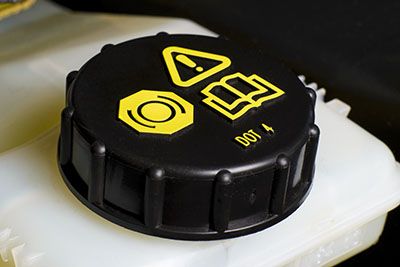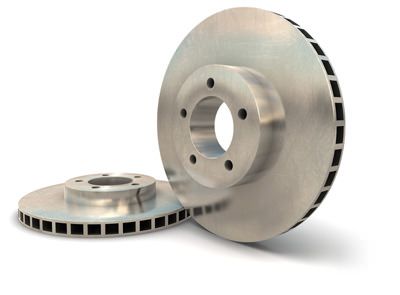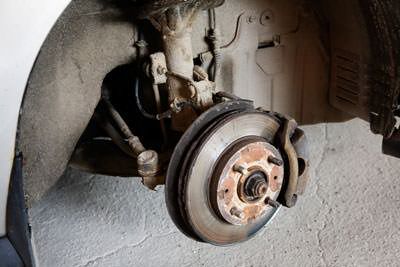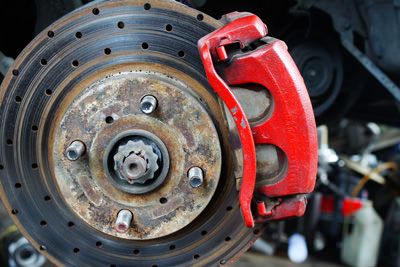What is brake fluid?
Brake fluid is a type of hydraulic fluid that is used in brake systems to aid in the movement of the brake pedal to actuate the brake pads at the wheels—thus stopping your vehicle. Brake fluid is also a lubricant and anti-corrosion fluid that helps to make sure that your vehicles brake system works optimally.
What are the most common brake fluid problems?
Traditionally, brake fluid problems occurred when moisture seeped into the brake fluid, but the service issues with fluid today are different than 20-30 years ago. In fact, moisture in brake fluid today isn't much of a service issue because modern construction techniques of flexible brake hoses have eliminated most brake fluid moisture intrusion issues.
Today, brake fluid can be accurately tested to determine replacement needs. This is because the most common issues stem from the levels of dissolved copper and depleted additive package in modern brake fluids. The level of dissolved copper in brake fluid is an indicator of the health of the brake fluid's additive package. When the additive package of brake fluid is depleted one of the negative results may be internal brake system component corrosion and or sludge build up.
What is brake fluid corrosion?
Brake fluid itself doesn't corrode but when the additive package, which is part of the brake fluid, is depleted or breaks down, the brake fluid no longer has adequate anticorrosive inhibitors so corrosion of internal brake hydraulic components may occur.
What is brake fluid additive package?
Brake fluid additive packages are additives that are blended into brake fluid stocks by manufacturers. Typically, a combination of anticorrosion inhibitors, anti-wear additives, anti-rust additives, acid neutralizing or pH balancer additives, anti-foaming additives, and viscosity stabilizers are blended into brake fluids.
With usage of the vehicle, the additive package blended into brake fluid when manufactured will not last forever. Depletion of additive packages is the main cause of brake fluid issues; resulting in the need for brake fluid service in vehicles.
Some common reasons the additive package will be depleted or break down over time from vehicle usage is:
- Heat or overheating generated by the usage of the vehicle's brakes.
- Overuse or maximum use of a vehicle's brakes on smaller or undersized brake systems while hauling heavy loads can easily exceed “normal” brake operating temperature ranges.
- Stop and go driving which can cause heat sinking and the passing off of the heat into the hydraulic system by the constant heat present in such driving conditions.
- Low-cost brake fluids may have low-quality additive packages, therefore, the additive package will be depleted or break down sooner under the above conditions.
- Thermal cycling or thermal shock caused by the temperature extremes of the vehicle's brakes under all driving conditions.
Common Brake Fluid Myths
Myth #1: Moisture is the primary problem with old brake fluid.
Today the breakdown of the additive package is the primary problem.
Before the application of modern flexible brake hose manufacturing techniques moisture was an issue. It would permeate through the hoses and into the fluid when the fluid cooled down. Modern hose manufacturing has eliminated this issue.
Myth #2: Brake fluid never needs to be changed.
In modern vehicles brake fluid needs service when the copper content is 200 PPM (parts per million) or more. This will renew the additive package of the brake fluid and the protection it offers.
Myth #3: Just changing the fluid in the master cylinder is all the service ever needed to assure fresh fluid is in the system.
Just changing out the fluid in the master cylinder will not remove enough fluid to enable the new fluid to offer the necessary protection enabled by the correct additive package.
Myth #4: It's almost impossible to remove/change over half of the brake fluid in a system.
The brake fluid exchange service at Firestone Complete Auto Care includes removing the old fluid in the master cylinder, refilling it, and then removing the fluid at all four wheels (performed as specified by the manufacturer), which removes most of the old fluid. The fluid is then tested again using the test strip to assure that there is no or almost no copper remaining in the system.
Myth #5: ABS systems usually don't work well after a brake fluid exchange.
If the ABS system doesn't allow free flow of fluid through the HCU (hydraulic control assembly) the FCAC technician may have to use a scan tool to actuate the HCU valves while flowing clean fluid through the system (performed as specified by the manufacturer).
Myth #6: The same type of brake fluid can be used in all types of vehicles.
Different vehicles with different types of brakes require different types of fluid. Our technicians will ensure the correct type of fluid is put in your vehicle, per the manufacturer's specifications.
Myth #7: There are no copper parts in a brake system so there can't be dissolved copper in the brake fluid?
The steel lines on a vehicles brake system start off as a flat piece of metal. It is then rolled into a hollow line and brazed with copper from the inside out making a seamless line. The copper alloy used to coat the inside of brake lines is where the copper content of brake fluid comes from. The brake fluid dissolves it from the interior of the brake lines and suspends it in the fluid.



